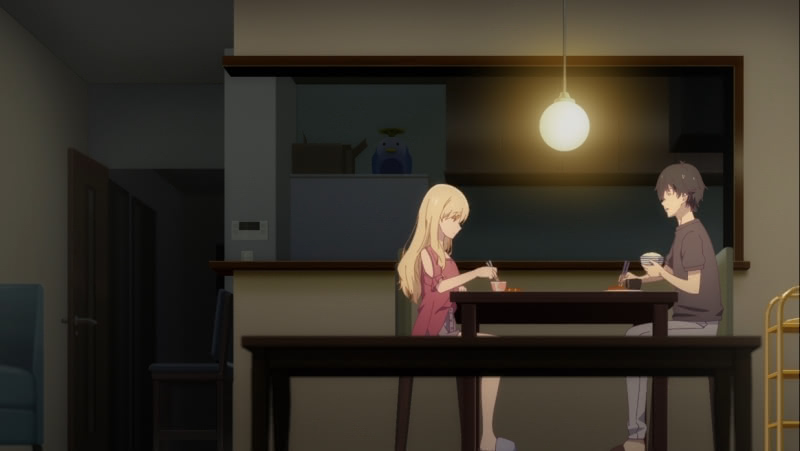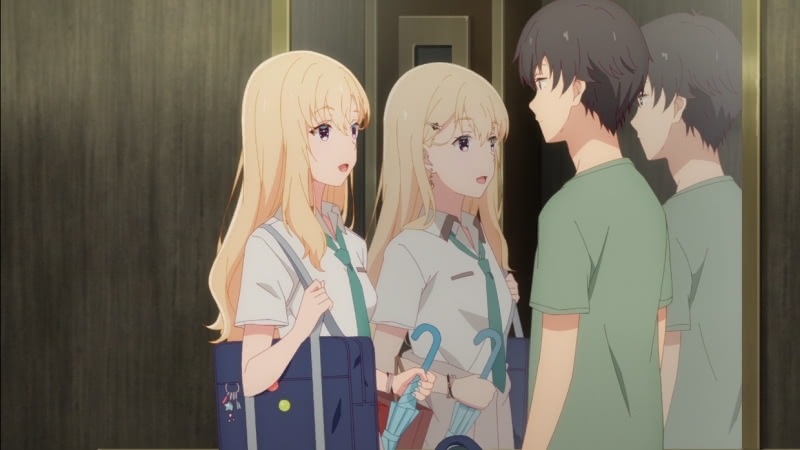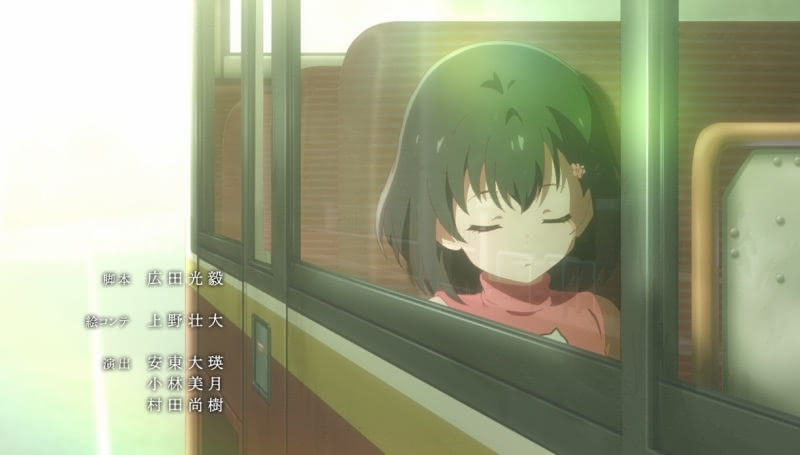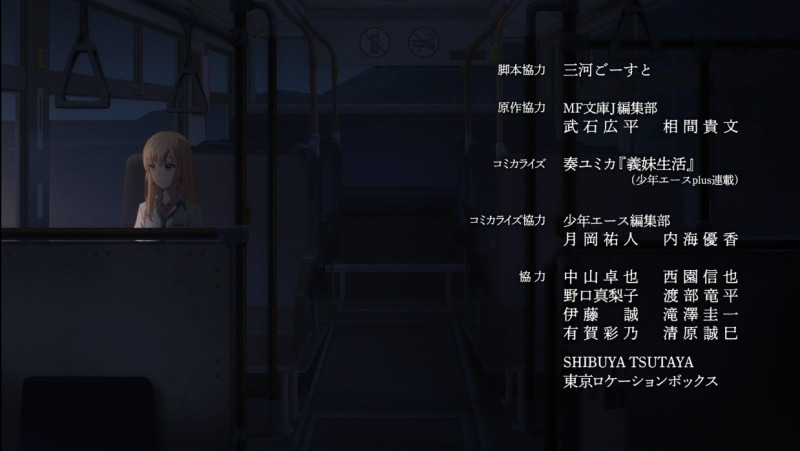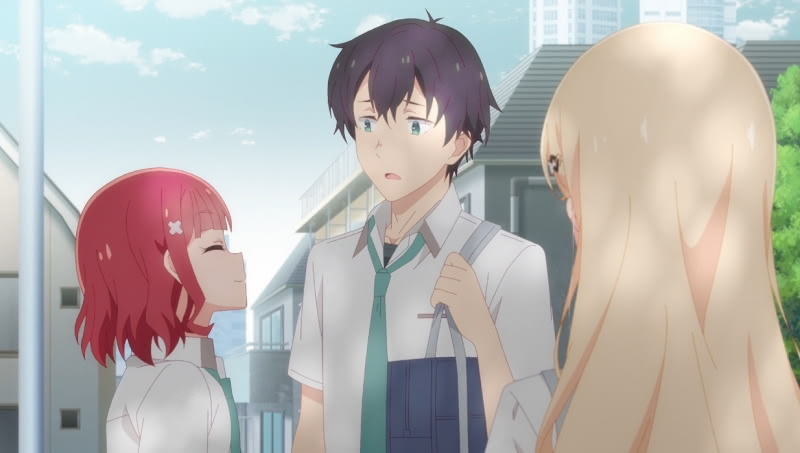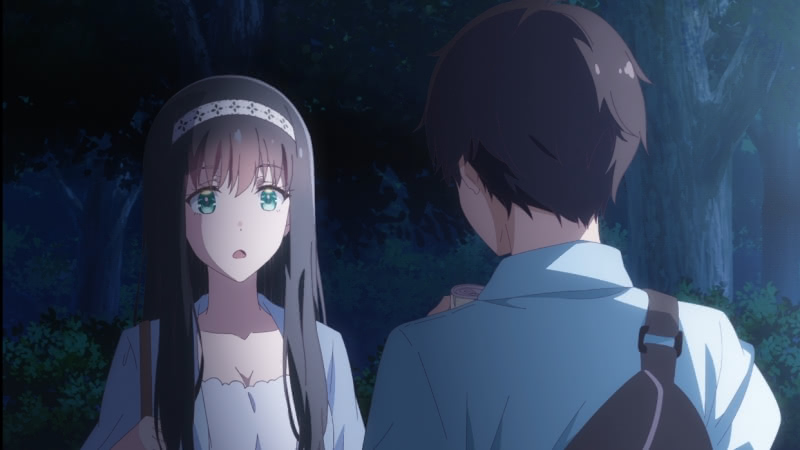On August 1, 2024, an interesting Anime News Network headline crossed my RSS feed: Can an Anime be ‘Carried by its Animation’? Late that same day, a headline from the always-excellent Sakugablog hit my feed reader: Gimai Seikatsu: An Eclectic Mix of Avant-Garde and Ordinary to Rise Above Limitations. I am not sure there has ever been so clear a case of one article in my feed set indirectly answering a question raised by another. Better yet – I thought of Gimai Seikatsu, localized by Crunchyroll as Days with My Stepsister, as soon as I saw the Anime News Network headline. This is actually going to turn into an anime hair color analysis article in addition to a anime carried by animation take, but we have to work our way there first.
Update: I subsequently published a full review of Gimai Seikatsu. I nevertheless recommend starting here because my review references back to avoid re-inventing the wheel.
Introducing Gimai Seikatsu, or Days with My Stepsister
Gimai Seikatsu, or Days with My Stepsister, is an ongoing (as of the date of the publication of the instant article) anime series produced by Studio Deen. As of this writing, 6 of what will be 12 episodes episodes have already aired. It is based on a light novel series by someone who goes by Ghost Mikawa.
For many reasons this was not a show high on my summer season 2024 to-do list. The premise — the parents of a teenage boy and teenage girl get married and then the boy and girl are living together and who knows where this will go!? — has been done before. There was the mid-90s series Marmalade Boy (I tried it without knowing the premise and made it about one-quarter of the way before conceding defeat). I included a somewhat novel take on the genre, My Stepmom’s Daughter is My Ex (more or less exactly as advertised by the title), as an honorable mention in my 2022 anime year-end review and noted there that “[h]ad this series not insulted my intelligence for large swaths of the first half … it may have had a real shot at [my 2022] top-six.” Although I qualified this surprisingly non-negative assessment by noting that its being in the mix for a top-six ranking in 2022, this probably said more about my estimation of the overall quality of anime in 2022 than of the show in question (noting my sixth place series was Heroines Run the Show: The Unpopular Girl and the Secret Task, an anime inspired by a virtual idol song). I suppose Stepmom’s Daughter is my Ex proved that it is possible to take an inane premise and do something decent with it, especially if one could avoid some of the excesses of light novel-ism that nevertheless plagued this particular show in its lesser moments.
(To be sure, My Stepmom’s Daughter is my Ex probably also benefits from ending in medias res since it does not leave one with the impression that the source material on which it is based was going to take things in a bold, unexpected direction. This is neither the first nor most extreme case of such a phenomenon in anime.)
The purpose of this article is not to review the plot of Days with My Stepsister, but a very brief introduction is still in order. The two protagonists and view-point characters are Yuuta Asamura (the boy) and Saki Ayase (the girl). Yuuta is a serious and studious second-year high school student (11th grade in American grades) who also works part-time at a bookstore.
He lives with his father, who seems to have a good-paying job (enough to buy a fairly nice, albeit not extravagant, apartment). Saki is a blonde (we will get to that) melancholy girl with an attention-grabbing fashion sense. She lives with her mother, who works as a hostess at night. Yuuta’s father and Saki’s mother fall in love before the first episode starts, and they had apparently already decided to get married before they held a two-family meeting (in Yuuta’s case, his father told him very little going into the meeting, which led to a certain misunderstanding that we will get to in the hair color section of this article). It is only there that Yuuta and Saki meet for the first time and realize that they are classmates – although they had never spoken to each other at school (My Stepmom’s Daughter is My Ex had a similarly convenient introduction story – but I will grant that both of these set-ups are mercifully less insane than Marmalade Boy).
There is not much to say about the actual plot of the show – significantly less than its somewhat similarly structured 2022 counterpart, in fact. My Stepmom’s Daughter is my Ex at least gave itself a hook: The step-siblings had actually dated in junior high school before breaking up on bad terms, and all of that happened before either had any idea that their parents would meet and get married (the show’s most recommendable plot-line had nothing to do with the main characters being step-siblings; instead, the show looked back and depicted how their relationship imploded in what was a surprisingly plausible depiction of how relationships between bookish middle school students of above average intelligence and expected life experience and emotional maturity are likely to implode). Conversely, Days with My Stepsister lacks an obvious hook, or perhaps that is the hook. The Sakugablog article noted that the premise of the original work was taking a tropey set-up and trying to play it completely straight. Both Yuuta and Saki are reserved, lonely, and a bit depressed in their own ways (especially Saki on the latter point). While they are initially somewhat committed to being strangers, they quickly find that they get along and grow close – although Saki’s being in awe of Yuuta’s generally polite and upstanding behavior perhaps stretches credulity. It has its moments of inanity – notably a sequence in the third episode that brought me closer to dropping the show than I ever came in My Stepmom’s Daughter is my Ex (and that show had its share of genuine light novel stupidity, mind you). However, the actual plot and writing are mediocre in the way one would expect from something that has aspirations of being a high-minded take on a cliche set-up without the commensurate clear and distinct idea of how to transcend it other than building a brooding atmosphere around its very understated main duo.
Days with My Stepsister Carried by Aesthetics
So why am I still watching? After all – I noted in reviews of 2024 anime series The Dangers in My Heart (season 2) and A Sign of Affection and an article discussing in part the third season of Sound! Euphonium – 2024 has been full of high-level shows. While my final assessment will have to wait until late December/early January, it should be obvious from everything I have written that 2024 is not a year in which the likes of my 2024 sixth-place finisher, Heroines Run the Show: The Unpopular Girl and the Secret Task, or either of the two recent step-sibling shows I have discussed, are going to be vying for top-six placements in my year-end ranking (2022 was a bit rough after the top two shows…). To be clear, the plot and writing of Days with My Stepsister are not awful (not by broader anime standards, much less by the standards of its particular set-up); I would classify it as mediocre. The answer to why I am still watching this show is my answer to the question-in-headline I led the article with: Can an Anime be ‘Carried by its Animation’? Yes it can! To a point…
Days With my Stepsister is not carried by animation in the sense one would likely ordinarily think. I imagine that most would interpret the question similarly to how the Anime News Network commentators did in the article with the headline – can an anime series with elite production values carry an otherwise mediocre series? For example, I watched the first season of Shangri-La Frontier (“SLF”), an anime largely set in a virtual reality video game that aired in fall 2023 and winter 2024, in significant part because of its elite production values. The video game premise is close to what I tend to avoid in anime, although I appreciated that SLF is actually about people having fun playing a video game instead of being transported into a video game world after being hit by a truck, but the premise lends itself to giving the show limited upside. SLF is pleasant enough in its better moments, however, its top-flight production values – especially in the area of choreographing some of its in-game-world combat — are absolutely necessary for the show being somewhat recommendable given the thinness of its plot and unambitious writing. SLF was carried by its animation – but not to the point where I would say it is a great show or anything close to that designation, but instead to the point where it can be fun to watch despite its limitations.
Conversely, Days With my Stepsister, unlike SLF, does not benefit from big budget production values (one need not spend much time with SLF to see that money was not a significant issue). I quote from the beginning of Sakugablog’s essay on the show:
On this site, we tend to talk about anime with relatively high production values. Mind you, this isn’t due to any particular fondness for larger, more expensive projects than the norm. If anything, we regularly find ourselves singing the praises for teams who consistently punch above their weight; something achievable through resourcefulness from both creators and management teams, as is the case for this season’s Makeine and their beloved production line.
Makeine is another flawed show airing in summer 2024 that benefits significantly from some good animation work (although I would argue more notably this is true with reference to one character than the entire aesthetic), but this article is about Days with My Stepsister. It takes the Sakugablog post a bit to get into its analysis of the show with which we are concerned, but the opening paragraph sets up an interesting point: Days with My Stepsister is very notable for its audio-visual aesthetics, but its audio-visual aesthetics do not derive from big resource investment. I will quote one passage from the article, but first note that “Ueno” refers to the first-time director of the show, Takehiro Ueno:
If we return to the original topic of conversation while examining this fascinating adaptation, it’s easy to notice how many of these choices allow it to get away with its limited means. Smart construction and those interesting sensibilities solve the issues of limited screentime; a lengthy conversation about the usefulness of Lo-fi Beats To Study To channels was distilled by episode [4] into a moody montage of such sounds over a rainy day, making it both faster and more sensorially appealing. That casual, still camerawork with a plethora of long shots reduces the number of assets needed, and somewhat camouflages the shoddy drawings. Of course, this doesn’t mean that the show is better for those limitations—Ueno has simply proved that he’s capable of creating something exceptional even when shackled by those. Though it’s certainly true that he was lucky that he was entrusted with interesting material for his debut, as well as with an environment that didn’t attempt to restrict the broad vision he so clearly has, it also makes you wish for the best of both worlds. Sure, it’s cool when an up-and-coming director rises above less-than-ideal conditions, but it might be even better if he was in a situation where those aspects further elevate him rather than attempt to hold him back. To any producers reading this, you know what to do.
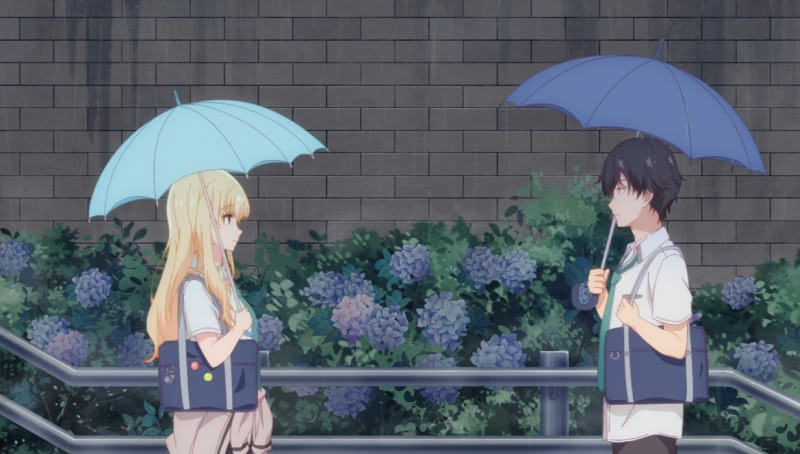
Indeed – Days With my Stepsister is a very aesthetic show, despite its obvious budgetary limitations. It has terrific cinematography, which is far from a given in anime, standing out in that area much like my fourth-place series from 2023, BanG Dream! It’s MyGo!!!! did last year (albeit that had a very different style and while the cinematography was necessary for its high placement on my year-end ranking, the story fundamentals and writing were much stronger than Days With my Stepsister). It is nice to see a team behind an anime not only take the time to enage with that which they are adapting, but also to think critically about how best to present the work in a different medium. Mr. Ueno and Studio Deen are giving terrific accounts of themselves with this particular work. I too would love to see what Mr. Ueno can do with – to put it charitably – better material. The Sakugablog article comes off a little bit more positive about the writing quality in Days With my Stepsister than I am able, but I agree fully with its positive takes on the camerawork, animation, and background music. For a quick idea – I recommend watching a short (about 10 minute) video analysis of the animation work in the first few episodes by Takafumi of the Please no Hate blog.
Without Mr. Ueno’s superlative direction, Days with My Stepsister would be a forgettable anime adaptation of material struggling to outsmart itself. But when we consider its superlative aesthetic sensibilities – well, it is still an animation adaptation of material struggling to outsmart itself – it is a recommendable adaptation for people who appreciate excellent anime cinematography and attention to detail in visuals, even if accounting for the apparent limitations of the underlying material.
(Note: While Days With my Stepsister would have to transmogrify into one of the great anime shows of all time in its latter half to have a shot at my year-end top-six – something I am more than confident will not occur – it will likely be in the running for a couple of category-specific awards, although I will submit for the record that 2024 will not be an easy year to break through in the anime aesthetics category.)
Hair Color in the World of Days With my Stepsister
I am not an astute animation analyst on the level of kViN of Sakugablog or Takafumi, but there is one area where I am a [self-proclaimed] world-leading expert: Anime hair color analysis.
(See my full collection of posts on hair color in Japanese anime, manga, novels, and games.)
Days With my Stepsister has a very obvious case of hair dye – so obvious it hits you with it in the opening theme song much like what we saw in the spring 2024 series Jellyfish Can’t Swim in the Night, but with even less subtlety. It ordinarily would not have necessarily been the sort of anime that I would turn into a hair color analysis piece – but having been given a reason to write about it anyway, we might as well take a look.
The first step to understanding hair color in anime is understanding the world in which the anime is set. Days With my Stepsister is one of the more down-to-Earth, realism-inclined anime shows that you will find (certain plot conveniences aside). The characters attend a completely ordinary high school in modern-day Japan and live in what appears to be a modern-but-very ordinary apartment. The vast majority of characters that we see have black or very dark brown hair of the kind one would expect to find on the heads of Japanese people. One of the three notable exceptions in the show is Saki Ayase, the step-sister, who has bleach-blonde hair.
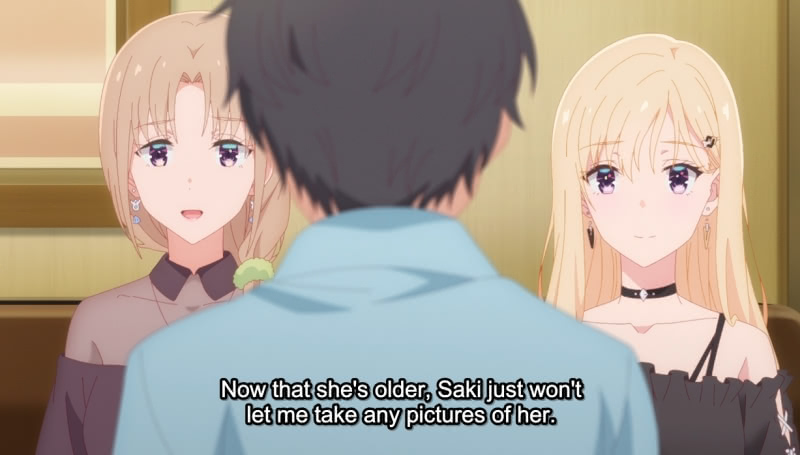
The first few minutes of the first episode provide more than enough context to lead one to suspect that there is a reason Saki’s hair is not like the others – and that the reason is most likely not mere artistic discretion (or indiscretion – I suppose it depends on your views on anime’s tendency toward unexplained exotic hair color). In the above screenshot, we see the back of Yuuta’s head, as he sits across from Saki’s mother (left) and Saki (right). Neither Saki’s mother nor Saki have the sort of black or brown-inclining-to-black hair that one would ordinarily expect in Japan (see, for example, Yuuta and his black hair). Note that I have Crunchyroll’s caption in the image. Saki’s mother is saying: “Now that she’s older, Saki just won’t let me take any pictures of her.” Careful viewers would have caught a scene a couple of minutes prior wherein Yuuta was looking at a photograph of his new little sister whom he was set to meet (note Yuuta and Saki were born within a few days of each other – so little is very [step-]relative here). See the image below:
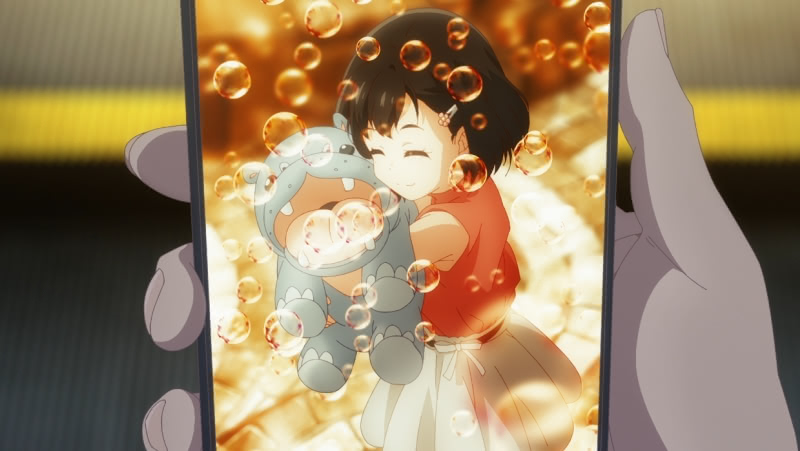
Yuuta had been provided with a photograph of a much younger Saki. As you can see, little Saki has very dark brown-to-black hair, much like Yuuta (talk about a very convenient misunderstanding). The two possibilities here are that she is dying her hair or mysteriously went bleach blonde as she grew older. Spoiler: She is dying her hair. Saki’s mother is by all indications Japanese, so we can infer that she, like Saki, is also dying her hair, albeit Saki’s mother appears to have light brown hair instead of Saki’s more bleached look (I previously covered a blonde vs brown question).
I previously mentioned the opening theme song. The first episode does not have a theme song at the start – it instead runs the opener at the end of the episode (thereafter, the opener is used at the beginning of every episode beginning with 2). The opening theme song starts with a young Saki and Yuuta sitting on opposite sides of a bus (I assume this is all symbolic and not foreshadowing that they forgot they were childhood friends who promised to marry each other way back in the day – but you never know with these kinds of things). We are not concerned with Yuuta here since he had the same hair color as a child that he has as a teenager. Saki, however, does not – we see her as a chile with the same hair she had in the photograph Yuuta was looking at.
Lest one had any doubt about what is happening – there is a scene at the end of the theme song with the current, teenaged Saki, sitting in the same seat as her younger dark-haired self:
I tend to cover anime hair color stories where we need to interpret clues and gather evidence to fully understand the hair color situation. Days With my Stepsister is a bit more forthright than the ordinary case – it tips its hand in the opening minutes of the first episode and reminds viewers with the opening theme song visuals in every other episode. Saki does actually address why she presents herself in the way she does without specifically addressing her hair color (Saki’s overall fashion sense matches her flashy bleached hair), but it is fairly mundane and in line with Saki’s characterization (I noted her personality is reserved and somewhat standoffish, contrary to what one would expect from a character with her design – a contrast which certainly exists by design).
I said there were three significant characters with striking hair colors. Let us meet Saki’s best friend, Maaya Narasaki. Maaya has what I can only describe as strawberry-red hair (ripe strawberry at that):
Maaya stands out in many ways. Her hair stands out because in the few scenes we have set in the school, the vast majority of students have ordinary hair (I noted a couple of girls with brown hair in the background – but Maaya and Saki are genuinely unusual). As a character, Maaya stands out because of her personality. Yuuta and Saki are are both very subdued and straight-forward – lacking overt anime tropes and seldom even changing their inflection (I will note that Saki’s voice actress, Yuki Nakashima – is notably good even from the perspective of someone who cannot understand anything she is saying). Maaya though – Maaya is incredibly anime (again, for lack of a better term). They plucked her out of some over-the-top anime comedy and dropped her into what may be the slowest-paced character drama of the year. To reference one of my past reviews, I think of her as this show’s counterpart to Chitose Shirakawa in The Angel Next Door Spoils Me Rotten, but Chitose if she was not occupied with her own life and relationship and dialed up to 11. One minute we have Yuuta and Saki awkwardly pontificating over dinner in their dimly-lit kitchen. The next minute Yuuta is begging Maaya (who is in on the step-family secret) to stop playfully calling him big brother at school, while Maaya is peppering him with questions after having apparently spent some time huffing helium in the girl’s restroom. I am mildly curious what they are doing with Maaya – given that it is obvious her over-the-top, incredibly cliched personality is clearly a deliberate contrast in a show that intends to play a cliched topic in a serious, grounded way, but at the same time I find her voice over extended periods more difficult than any anime voice since Aoi Oribe in Myself;Yourself (you get to pat yourself on the back if you get that reference; and you also have my sympathy).
But enough about Maaya’s character – this is about hair color.
I have not yet noted any reference to how or why Maaya has strawberry red (as opposed to strawberry pink) hair, but given the evidence we have about the show’s world and setting and that it is obvious Saki is dying her hair, I am reasonably confident that Maaya is not a natural red head. We have an additional clue in the only significant character (at least through six episodes) other than the Asamura-Ayase blended family and Maaya: Yuuta’s co-worker Yuuta’s friend and co-worker Shiori Yomiuri. Yoimuri is a college student and, like Maaya, has a bubbly personality. However, Shiori is self-aware and enjoys Yuuta’s company (not to mention teasing him). Unlike Maaya, she does not feel like she stumbled into the wrong anime. Having noted that every significant female character we have covered thus far has an unusual hair color, one would have to at least consider the possibility that if Shiori too has an unusual hair color, the show is using this trait to distinguish the main female characters from background characters. However, Yoimuri is far closer to Yuuta in this area than she is to Saki and Maaya.
Even if Shiori did not exist to prove beyond doubt that major female characters in Days with My Stepsister can have undyed hair, I would still be reasonably confident that Maaya is dying her hair red based on the show’s setting and the overwhelming evidence that the blonde Saki has naturally black hair. My confidence is only curbed by the fact that she comes off as having been cast from another planet into a show where she does not belong.
Maybe she is an alien (I am undecided on whether she is an alien from a different planet or different show).
In any event, if we learn something interesting about Maaya’s hair color or inter-planetary origins in the latter half of the show, I may cover the subject in these pages.
